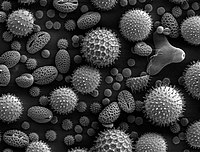
Photo from wikipedia
High-end microscopy studies of G protein-coupled receptors (GPCRs) require installing onto the receptors bright and photostable dyes. Labeling must occur in quantitative yields, to allow stoichiometric data analysis, and in… Click to show full abstract
High-end microscopy studies of G protein-coupled receptors (GPCRs) require installing onto the receptors bright and photostable dyes. Labeling must occur in quantitative yields, to allow stoichiometric data analysis, and in a minimally invasive fashion, to avoid perturbing GPCR function. We demonstrate here that the genetic incorporation of trans-cyclooct-2-ene lysine (TCO*) allows achieving quantitative single-residue labeling of the extracellular loops of the β2-adrenergic and the muscarinic M2 class A GPCRs, as well as of the corticotropin releasing factor class B GPCR. Labeling occurs within a few minutes by reaction with dye-tetrazine conjugates on the surface of live cells and preserves the functionality of the receptors. To precisely quantify the labeling yields, we devise a method based on fluorescence fluctuation microscopy that extracts the number of labeling sites at the single-cell level. Further, we show that single-residue labeling is better suited for studies of GPCR diffusion than fluorescent-protein tags, since the latter can affect the mobility of the receptor. Finally, by performing dual-color competitive labeling on a single TCO* site, we devise a method to estimate the oligomerization state of a GPCR without the need for a biological monomeric reference, which facilitates the application of fluorescence methods to oligomerization studies. As TCO* and the dye-tetrazines used in this study are commercially available and the described microscopy techniques can be performed on a commercial microscope, we expect our approach to be widely applicable to fluorescence microscopy studies of membrane proteins in general.
Journal Title: ACS chemical biology
Year Published: 2019
Link to full text (if available)
Share on Social Media: Sign Up to like & get
recommendations!